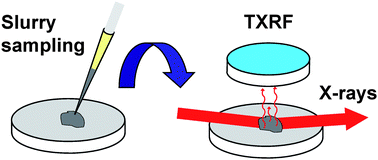The direct determination of Ca, Co, Cr, Cu, Fe, Mn, Ni and Ti in boron carbide powders with different particle size distributions by means of slurry sampling total reflection X-ray fluorescence spectrometry (TXRF) has been described. The stability of the slurries was monitored by measuring the zeta potential for different pH values and different concentrations of polyethylenimine (PEI). It was found to have a maximum for a PEI concentration of 0.1% and a pH of 4, which were the conditions of the highest stability of the slurries selected for all further measurements. The slurry concentration for the TXRF measurements was optimized with respect to the net intensity and to the signal-to-background ratio for the trace analytes Ca and Ti and for the internal standard Ga. For dry slurry residues of 150 µg boron carbide, the signal-to-background ratios were found to be maximum and to be 5, 23 and 100 for 13.7 ng Ca, 29.1 ng Ti and 15 ng Ga, respectively. For calibration, the addition of Ga to the slurry up to a concentration of 1 µg mL−1 and the use of the Fe present in the sample as internal standard were investigated. Both approaches gave results in TXRF, which are in good agreement with the results of ICP-OES subsequent to wet chemical digestion at the 2 to 1200 µg g−1 concentration level for Ca, Co, Cr, Cu, Fe, Mn, Ni and Ti. The detection limits for these elements in TXRF were found to range from 0.1 to 1.2 µg g−1, and excepted for Ca and Mn, they are in the same range as those for ICP-OES after wet chemical digestion. The relative standard deviations, in the case of the finest powder, range from 1.9% for Ca to 18% for Cr and the average of the relative standard deviations for all elements determined is 9.2%. The correlation coefficients of the determinations of Fe and Ti in seven different boron carbide powders by ICP-OES and TXRF with R = 0.996 and R = 0.997, respectively, were found to be practically equal.


 Please wait while we load your content...
Please wait while we load your content...